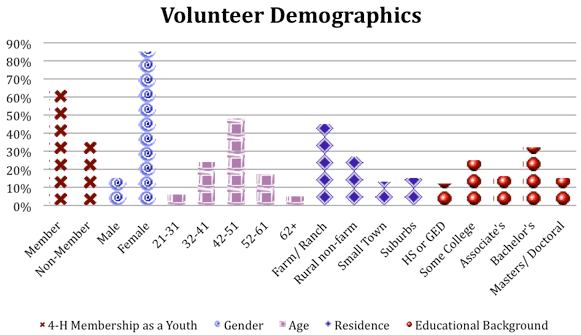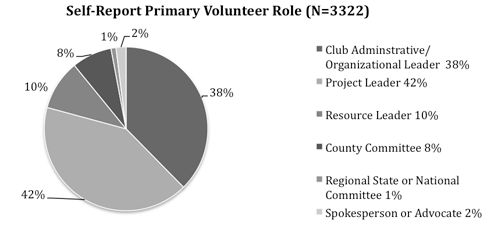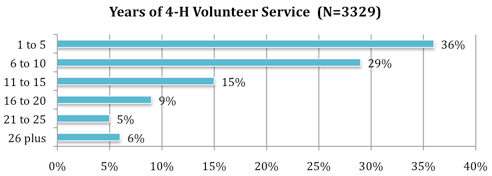 |
April 2012
|
April 2012 // Volume 50 // Number 2 // Research In Brief // v50-2rb2
North Central Region 4-H Volunteers: Documenting Their Contributions and Volunteer Development
Abstract
Documenting volunteer contributions strengthens Extension partnerships with volunteers. A team of North Central Region 4-H volunteer specialists collaborated to conduct a study of 4-H volunteer contributions and impacts related to working with youth within the 4-H program. Over three thousand (3,332) 4-H volunteers from throughout the 12-state North Central Region completed the survey. Volunteers are critical partners to the success of 4-H, making it possible for millions of young people to have access to 4-H programs.
Study Need and Background
4-H Youth Development offers non-formal learning experiences for six million young people across America and can be found in every county in every state, including the District of Columbia and Puerto Rico, and in dozens of countries around the world. 4-H involves Extension staff from the 106 land-grant universities and over 518,000 volunteers who partner with staff and young people to deliver and lead learning opportunities across the U.S.
In 2008, North Central Region Extension volunteer specialists conducted a multi-state study to define and quantify the contributions of volunteers in 4-H across the 12-state region. The study purposes were to document volunteer contributions to 4-H organizations and to the region as a whole and to increase stakeholder awareness of the types and level of contributions made by volunteers to 4-H and Extension.
Study Methods
The North Central Region represents Extension services in 12 states. Specialists developed and piloted the survey at the 2007 North Central Region Volunteer Forum in Wisconsin to test the face validity and the response formats for the items. The finalized 31-item survey (Chapin, Levings, Nippolt, & Pleskac, 2009) was administered online using Zoomerang™, a commercial, Web-based survey tool. An online survey method was selected in order to keep the study cost effective and because state organizations had email addresses in their respective database records. Michigan State University acted as the lead state, hosting the online site and compiling the data. Each institution's internal review board in the participating regions reviewed the study and approved the methods for human subjects.
The survey was designed to gather:
- Demographic background of participating 4-H volunteers,
- Programming through which adults volunteered within 4-H,
- The time and personal resources volunteers provided.
Sampling & Results
The total population of volunteers across all eleven11 states in 2008 was 133,160 individuals, with a range from just over 2,600 volunteers to 23,000 volunteers per state. From a convenience sample of volunteers who provided email addresses, each state randomly selected approximately 800 individuals from this pool of volunteers. Potential participants received up to two follow-up reminders at intervals of approximately 2 weeks. However, administration of the survey was led independently by the partner within each state, and there were slight variations in administration. Data were collected from spring through fall 2008.
The survey was sent to over 9,000 volunteers across the 11 participating states. The response rate of useable surveys was 37%, with 3,332 surveys returned. While a formal comparison of respondents to non-respondents was not conducted, the respondents from 10 of the 11 participating states were individuals with access to computers and the Internet. One state partner conducted the survey using a pencil-and-paper format.
Data Analysis
Data were analyzed using basic descriptive statistics. Statistical analyses were completed to investigate relationships between characteristics of respondents and their roles and tenure as 4-H volunteers. Cross tabulations were conducted on selected variables, and Pearson's chi-square tests were performed to test for significant relationships among selected characteristics and responses from the survey participants. Due to the response formats used in the survey design, it was not possible to calculate means for the responses.
Results
Demographic Profile (Figure 1)
Figure 1.
Respondent Demographics (n =
3,157)

Over two-thirds of respondents were 4-H members as youth, and most survey respondents (85%) were female. Almost half of respondents were ages 42 - 51. Nearly half (45%) of respondents lived on a farm or ranch, and nearly half (48%) were between the ages of 42 - 51 years. Nearly half of respondents earned a bachelor's degree and/or a graduate degree (47%).
Roles of 4-H Volunteers (Figure 2)
Respondents reported serving in a variety of key roles. Primary roles are identified in Figure 2. Serving as a project leader was the primary role for 42% of the respondents, while 38% indicated that their primary role was as a club administrative/organizational leader. Respondents, on average, served in two 4-H volunteer roles.
Figure 2.
Primary Volunteer Roles

When asked to report all the 4-H venues in which they provided service, the primary settings were within the 4-H community club (90%) and with local, regional, or state fairs (59%). Forty-one percent indicated they serve in 4-H on committees, boards, and councils. Eleven percent volunteered with after-school or school programs. An additional 6% volunteered at the regional or state level in an advisory or planning role.
Length of Service (Figure 3)
On average, respondents served approximately 8t years in 4-H. As demonstrated in Figure 3, 65% of the volunteers were in their roles for 10 years or less. In contrast, 11% reported serving as a 4-H volunteer for at least 21 years.
Figure 3.
Years of Service

Time with Youth and Planning (Figure 4)
Respondents were asked to consider their year of volunteer service to 4-H during a 9-month school year from September to May and then during the summer months of June to August. They were also asked to determine the amount of time spent in planning and preparing for their volunteer roles. The service hours included those spent volunteering on councils, boards, and committees, as well as time spent in their volunteer roles at local, regional, or state fairs. Figure 4 reflects the service hours in planning and direct contact.
Figure 4.
Average Monthly Hours Planning
and in Direct Contact with Youth

Youth Reached
Volunteers were asked to estimate a range in number of youth in three age groupings with whom they had contact during the previous 4-H year: youth 5 - 8 years of age, youth 9 - 13 years of age, and youth 14 - 19 years of age. Most respondents worked with at least one youth in each of the age range groups, with the exception of the 5 - 8 year old age group. Twenty-four percent of all respondents reported not working at all with this youngest age group, which typically are served in "Cloverbud" programs.
Other Contributions
Additional contributions while in the volunteer role included making telephone calls, sending emails, traveling in personal vehicles, and spending money for program supplies. While the number of phone calls and emails ranged from zero to more than 21 per month, the median number of telephone calls and emails per month was four and five, respectively. When considering the miles driven in personal vehicles for 4-H, the range was from zero to more than 250 miles. Volunteers traveled a median number of 11 miles per month for their service roles. While 21% of the volunteers spent $26 to $50 on non-reimbursed supplies, 2% reported spending over $500. The median contribution was $26 for non-reimbursed supplies. Over two thirds of the volunteers made additional financial contributions to 4-H.
4-H Involvement as Youth
In the group of respondents surveyed, there was a tendency for their length of service to be more than 5 years in length if they were youth 4-H members. Sixty-nine percent of the respondents who were volunteers for more than 5 years were also 4-H members as youth, whereas only 31% of these longer-term volunteers were not members as youth.
Benefits and Impact
Volunteers were asked how the 4-H volunteer experience influenced them in their personal lives. The qualitative responses fell into four main areas. 4-H provided adults with:
- Opportunities to be involved with youth learning,
- Opportunities for personal growth,
- Opportunities for contributing to the 4-H mission and giving back to the organization, and
- Social benefits including building social capital and community.
Overall, the benefit most often listed by respondents was that the 4-H volunteer experience contributed to the respondents' ability to become a better person. The examples of "becoming a better person" included increased self-confidence, improved social skills, increased community connections, learning new subject matter, and having a creative outlet within which to learn. Other frequently mentioned influences included the opportunity to help youth learn and grow.
Respondents were asked to describe the impact they believe they had on youth through their 4-H volunteer role. Responses fell into two categories—the action the adult provided or what they believed youth gained. Respondents most often reported they provided opportunities, exploration, a positive environment, and teaching to youth. Those respondents who reported impacts directly for youth most often reported that youth gained leadership skills, self confidence, and other skills such as problem solving and social skills, as a result of the volunteers' efforts.
Key Findings
Key Finding 1: The majority of respondents were ages 32 - 51 years. These respondents most often reported their role as an organizational/administrative or project leader. The role most often filled by this age group of volunteers is a role that involves working intensively with youth in club settings.
Key Finding 2: Respondents suggested that 4-H volunteers have completed more formal education than the general population. All respondents reported having a high school diploma, as compared to only 87% of the adult population age 25 years and older in the U.S (U.S. Census Bureau, 2008). Nearly one-third of the respondents reported having earned a bachelor's degree. This compares to 29% of U.S. residents (U.S. Census Bureau, 2008).
Key Finding 3: Nearly two-thirds (64%) of respondents reported that they have been in their volunteer role with 4-H for six years or longer at the time of the survey.
Key Finding 4: There was a notable decline in the number of respondents who have served 10 years or more in 4-H. The median was 8 years of service. The greatest number of respondents volunteered for 1 to 5 years.
Key Finding 5: Respondents tended to be more actively involved in programming during the summer months, with the median time commitment in the summer being 6 hours per week.
Key Finding 6: Respondents reported that hours spent in planning are roughly equivalent to hours spent in direct service with youth.
Key Finding 7: Volunteers gave more than time. Those surveyed reported mileage and supply contributions, with medians of 11 miles per month and $26 per year.
Key Finding 8: Volunteering for 4-H influences the lives of those who volunteer. The main influence on the respondents was becoming a "better person," as illustrated through several examples of increased self-confidence and other personal growth skills.
Key Finding 9: Volunteers most often reported impact on youth was their role in helping youth to gain self-confidence and learn new skills.
The study reported here provides an overview of the contributions of North Central 4-H volunteers based on responses from over 3,000 4-H adult volunteers. These findings are relevant for the development of, and management of, adult 4-H volunteers. In addition, a data-driven understanding of volunteer contributions sharpens the public value of Extension as a whole.
Volunteers provide millions of young people the opportunity to participate in 4-H programs. Field experts posit that short-term volunteers will be more productive and will be more likely to continue in their service if they are recruited, supported, and valued as partners in the educational process (Hart, 2005). As new volunteers are recruited to serve in 4-H youth development programs, the organization has a responsibility to foster a strong volunteer support system that sustains and develops this volunteer corps.
The results indicate areas that warrant deeper investigation in future studies. For example, research indicates that when individuals highly identify with their volunteer role, they are likely to contribute at higher levels to the program and to have longer tenure (Grube & Piliavin, 2000; Lee, Piliavin, & Call, 1999; Martino, Snyder, & Omoto, 1998). Given the positive relationship found in the study between experience as 4-H youth members and years of volunteer service, the identification with one's volunteer role in 4-H warrants further investigation.
The power of volunteerism in Extension can be captured with data systems that rigorously document the contributions made by volunteers on an ongoing, regular basis. Evaluation of 4-H programming can build upon the volunteers' reports of impact with youth. Extension is in the position to be a leader for the field of youth development and volunteerism by documenting and communicating the difference that volunteers make in the lives of young people who participate in 4-H.
Acknowledgements
North Central Region Volunteer Specialists: Rod Buchele, M.S. Ed. Kansas State University Extension; Julie Chapin, Ph.D., Michigan State University; Sondra Germer, M.S. University of Nebraska-Lincoln Extension; Chris Gleason, MPA Iowa State University Extension; Judy Levings, M.S., Iowa State University; Patricia C. McGlaughlin, University of Illinois Extension; Steve McKinley, Ph.D. Purdue University Extension; Pamela Larson Nippolt, Ph.D., University of Minnesota Extension; L.J. Osborne, Ph.D. South Dakota State University Extension; Sue Pleskac, M.S., University of Wisconsin - Extension; Vicki Schwartz, M.Ed, Ohio State University Extension;
Sheri Seibold, M.S. University of Illinois Extension; Doug Swanson, M.S., University of Nebraska-Lincoln Extension; Rachelle Vettern, Ph.D. North Dakota State University Extension; Mary Jo Williams, M.S. University of Missouri Extension.
The North Central Region volunteer specialists thank Tim Pleskac, Ph.D., Michigan State University, for statistical consultation and formula design, and Yuefeng Hou, M.E., the University of Minnesota, for statistical analysis and coding. Their expertise and generosity enabled us to complete this large, collaborative effort.
Reference
Chapin, J., Levings, J., Nippolt, P. L., & Pleskac, S. (2009). North Central Region 4-H volunteers documenting their contributions and volunteer development. Retrieved from: http://www.uwex.edu/ces/4h/ncrvd/research/documents/NCVolunteerContributionStudy11409final.pdf
Grube, J., & Piliavin, J. A. (2000). Role-identity, organizational experiences, and volunteer performance. Personality and Social Psychology Bulletin, 26, 1108-1119.
Hart, D. (2005). Recruiting strategies for short-term volunteers. Journal of Extension [On-line], 43(6) Article 6TOT6. Available at: http://www.joe.org/joe/2005december/tt6.php.
Lee, L., Piliavin, J. A., & Call, Y. R. A. (1999). Giving money, time, and blood: Similarities and differences. Social Psychology Quarterly, 62, 276-290.
Martino, S. C., Snyder, M., & Omoto, A. M. (1998). Predicting sustained volunteer service: Intentions and identity concerns. Paper presented at the annual meetings of the Midwestern Psychological Association, Chicago, IL.
U.S. Census Bureau and Customer Service Division census data. Retrieved from: http://www.census.gov/compendia/statab/2012/files/edu.html




